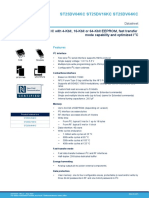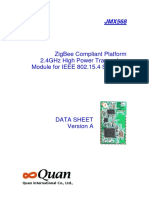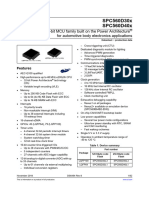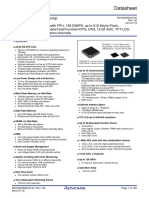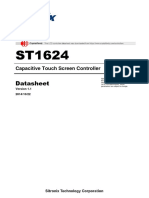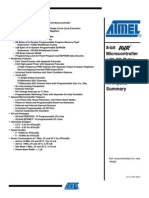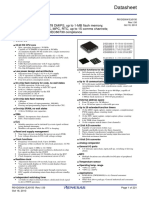SV6256P
Uploaded by
noc2csSV6256P
Uploaded by
noc2csPreliminary Data Sheet
SV6256P
Single-Chip Dual Band 802.11 a/b/g/n MAC/BB/Radio
with SDIO Interface
General Description SV6256P Features
The SV6256P is a low-power single chip All CMOS IEEE 802.11 a/b/g/n single chip
device providing for the highest level of Single stream 802.11n provides highest
integration for internet of thing embedded throughput and superior RF performance
systems. It is designed to support all for embedded system
mandatory IEEE 802.11b data rates of 1, 2, Advanced 1x1 802.11n features:
5.5 and 11 Mbps, all 802.11g payload data Full / Half Guard Interval
rates of 6, 9, 12, 18, 24, 36, 48 and 54 Mbps, Frame Aggregation
as well as 802.11n MCS0~MCS7, HT20/HT40, Reduced Inter-frame Space (RIFS)
800ns and 400ns guard interval. Space Time Block Coding (STBC)
It includes a dual band WLAN CMOS efficient Greenfield mode
power amplifier (PA) and an internal low noise Integrated WLAN CMOS efficient power
amplifier (LNA). The Radio Frequency Front- amplifier with internal power detector and
end is single-ended bi-directional input and closed loop power calibration
output.
ORDERING INFORMATION
The SV6256P has additional LDOs and DCDC
buck convertor that could provide noise Part Number Package
isolation for digital and analog supplies and
excellent power efficient with minimum BOM
Green/RoHS Compliant
SV6256P
cost. QFN 48L, 6x6 mm, 0.4mm pitch
The only external clock source needed for
SV6256P based designs is a high speed
crystal or oscillator. A variety of reference
clocks are supported which include 25, 40
MHz
All rights reserved
Proprietary and confidential information of iComm Corporation
July 2018
SV6256P Preliminary Datasheet 0.1
VDDIO VDD33
RF single-ended
Input / Output Antenna
LDO_EN
Matching
SDIO SV6256P System Clock
Other GPIOs
SV6256P System Block Diagram
iComm Proprietary and Confidential Page 2 of 26
SV6256P Preliminary Datasheet 0.1
Liability Disclaimer
iComm Cooperation reserves the right to make changes without further notice to the product. iComm
Cooperation does not assume any liability arising out of the application or use of any product or
circuits described herein.
Revision History
Version Date Owner Description
0.1 2018/08/7 Hoz Lin Copy and modify from SV6156P
iComm Proprietary and Confidential Page 3 of 26
SV6256P Preliminary Datasheet 0.1
Table of Contents
1 System Overview ..................................................................................................................... 5
2 Power Supplies and Power Management .......................................................................... 7
3 Interface Description ............................................................................................................ 11
4 DC Characteristics ................................................................................................................ 12
4 Frequency References ......................................................................................................... 16
5 Electrical Specifications ...................................................................................................... 17
6 System Power Consumption .............................................................................................. 19
7 Pin Descriptions .................................................................................................................... 21
8 Package Information............................................................................................................. 25
iComm Proprietary and Confidential Page 4 of 26
SV6256P Preliminary Datasheet 0.1
1 SYSTEM OVERVIEW
DC-DC
Power
Supply
LDO
PMU Ctrl 32K RTC
SLEEP CLK
Dedicated
XTAL OSC
Crystal
SDIO SDIO Bridge
POR LDO_EN
SYSTEM BUS
Wdog timer
MCU GPIO GPIO
UART_DEBUG
UART_DEBUG
SRAM
802.11 a/b/g/n
802.11n
Radio
MAC
802.11n
PHY
BT CO-EXISTENCE RF Switch Ctrl
Figure 1-1: SV6256P Block Diagram
1.1 General Description
The SV6256P WLAN is designed to support IEEE 802.11 a/b/g/n single stream with the state of-
the-art design techniques and process technology to achieve low power consumption and high
throughput performance to address the requirement of mobile and handheld devices. The
SV6256P WLAN low power function uses the innovative design techniques and the optimized
architecture which best utilizes the advanced process technology to reduce active and idle power,
and achieve extreme low power consumption at sleep state to extend the battery life. The
SV6256P WLAN A-MPDU Tx function maximizes the throughput performance while achieving the
best buffer utilization.
1.2 MAC Features
802.11 a/b/g/n/e/i/d
WLAN/BT coexistence mechanisms
802.11n features
iComm Proprietary and Confidential Page 5 of 26
SV6256P Preliminary Datasheet 0.1
– A-MPDU Tx & Rx
– Support immediate Block-Ack
AP/STA mode
– Soft-AP
Rate adaption mechanism
WFA features
– WEP/TKIP/WPA/WPA2
– WMM/WMM PS
1.3 PHY features
802.11b, 11g, and 802.11n 1T1R
Short Guard Interval
Greenfield mode
RIFS in RX mode
STBC in RX mode
Enhanced and robust sensitivity for wider coverage range
Supports calibration algorithm to handle no-idealities effects from CMOS RF block
1.4 HOST INTERFACE
SDIO 2.0
Standard SDIO 2.0 device interface
UART
Support RX/TX, 2 pins
Baud rate up to 921600
1.5 System Clocking and Reset
The SV6256P has a system clocking block and reset which controls the clocks and power going
to other internal modules. Its inputs consist of sleep requests from these modules and its outputs
consist of clock enable and power signals which are used to gate the clocks going to internal
modules. The system clocking and reset block also manages resets going to other modules
within the device.
1.6 Design for Test
It also has features which enable testing of digital blocks via ATPG scan, memories via MBIST,
analog components, and the radio.
iComm Proprietary and Confidential Page 6 of 26
SV6256P Preliminary Datasheet 0.1
2 POWER SUPPLIES AND POWER MANAGEMENT
2.1 General Description and PMU Power Connection
The power management unit (PMU) contains Under-Voltage Lockout (UVLO) circuit, Low Dropout
Regulators (LDOs), buck DC-DC converter and reference bandgap circuit.
The PMU integrated multi-LDOs and one buck converter. Those circuits are optimized for the given
functions by balancing quiescent current, dropout voltage, line / load regulation, ripple rejection and
output noise.
The input voltage of the buck converter is 3.3V. Its output voltage is 1.6V and feeds into the input
power of the RF circuit and DLDO which has 1.2V output voltage for all digital circuits.
Figure 2-1 shows the typical power connection for SV6256P. DLDO and some RF circuits are
powered by the buck converter output. The VDDIO is a power input which may be 1.8V or 3.3V from
the host side. The connection structure is shown in the figure below.
VDD33_PA
PA
3.3V
RF
(including VCO)
RF
VBAT Buck DC-DC VDDLX_DCDC 1.6V BB
Convertor
VDD33_DCDC VDD16_ABB
VDD16_SYN Digital
DLDO
VDDIO DVDDIO_SOC1 RTC & PMU
DVDDIO_SOC2
DVDD12
1.2V
Figure 2-1: SV6256P Power Connection
2.2 Under-Voltage Lockout (UVLO)
The UVLO state in the PMU prevents startup if the initial voltage of the battery is below pre-defined
threshold. It ensures that SV6256P is powered on with the battery in good condition. In addition,
when the battery voltage is getting lower, it will enter the UVLO state, and the PMU will be turned off
by itself to prevent further discharging.
iComm Proprietary and Confidential Page 7 of 26
SV6256P Preliminary Datasheet 0.1
2.3 DLDO
The DLDO is integrated in the PMU to supply digital core. It converts voltage from 1.6V input to 1.2V
output which suits the digital circuits. The input is typically connected to the buck’s output.
2.4 Buck Converter
The regulator is a DC-DC step-down converter (buck converter) to source 300mA (max.) with 2.0V to
1.5V programmable output voltage based on the register setting. It supplies power for the RF circuit
and DLDO.
2.5 Power Management Control
There are three power modes that SV6256P operates when it is initialized: HOST_OFF, ACTIVE
mode and SLEEP mode. There are two intermediate system transition modes: FW_DOWNLOAD
and WARM_UP mode. The following are the brief introduction to each mode.
HOST OFF
(LDO_EN=0)
Power & Clock settling done (<1.3 ms)
FW
DOWNLOAD
FW download done
ACTIVE Clock settling
WARM
SLEEP criteria UP
Interrupt occurs
SLEEP
Figure 2-2: SV6256P Power State
iComm Proprietary and Confidential Page 8 of 26
SV6256P Preliminary Datasheet 0.1
Table 2-1: SV6256P Power State Description
State Description
When LDO_EN pin is de-asserted and logically low, the chip is brought
to this state immediately.
HOST OFF Sleep clock and internal power supply is disabled.
After LDO_EN pin is asserted, the internal power and clock will be
settled down within 1.3 ms.
FW DOWNLOAD States for firmware download after power and clock is settled down.
The host controller can determine when to enter sleep to turn off most
circuit in SV6256P. All the RF, DPLL circuits are turned off. In sleep
SLEEP mode, the system could be awakened after the sleep time is expired or
by an external wake up signal from the host controller.
All internal states are maintained and the Crystal oscillator is disabled.
The system transitions from SLEEP to ACTIVE. The crystal or
WARM UP
oscillator is brought up and the PLL is enabled.
The high speed clock is operational and sent to each block by the
clock control register.
ACTIVE
The RF circuit is enabled to transmit or receive data, and the whole
system is under normal operation.
iComm Proprietary and Confidential Page 9 of 26
SV6256P Preliminary Datasheet 0.1
2.6 Power-on Sequence
Figure 2-3 shows the power-on sequence of the SV6256P from power-up to firmware download,
including the initial device power-on reset evoked by LDO_EN signal. The LDO_EN input level
must be kept the same as VDDIO voltage level. After initial power-on, the LDO_EN signal can be
held low to turn off the SV6256P or pulsed low to induce a subsequent reset. After LDO_EN is
assert and host starts the power-on sequence of the SV6256P. From that point, the typical
SV6256P power-on sequence is shown below:
1. Within 1.3 millisecond, the internal power-on reset (POR) will be done. And host could
download firmware code. The internal running clock is crystal frequency.
2. After 100us of DPLL settling time, host could set internal clock to full speed and finish all the
downloading of firmware code.
Ramp time > 50 µs
VBAT>2.95 V
VBAT
Ramp time > 50 µs
VDDIO>1.61 V
VDDIO
>60 µs
LDO_EN
<50 µs
DVDD12
<450 µs
<50 µs
DVDD16
<900us
Internal POR
DPLL settling time<100us
>1.3 ms
>100 µs
FW Download
DPLL configure setting Host downloads code
(if crystal is not 26MHz) (Host could change
internal clock to DPLL)
Figure 2-3: Power-on sequence
2.7 Reset Control
The SV6256P LDO_EN pin can be used to completely reset the entire chip. After this signal has
been de-asserted, the SV6256P is in off mode waits for host communication. Until then, the MAC,
BB, and SOC blocks are powered off and all modules are held in reset. Once the host has
initiated communication, the SV6256P turns on its crystal and later on DPLL. After all clocks are
stable and running, the resets to all blocks are automatically de-asserted.
iComm Proprietary and Confidential Page 10 of 26
SV6256P Preliminary Datasheet 0.1
3 INTERFACE DESCRIPTION
3.1 SDIO Timing Waveform
Table 3-1: SV6167Q SDIO version 2.0 Timing Specifications
Symbol Parameter Min. Typ. Max. Unit
Clock CLK (All values are referred to min(V IH) and max (VIL).
fpp Clock frequency Data Transfer Mode 0 50 MHz
tTLH Clock rise time 3 ns
tTHL Clock fall time 3 ns
Inputs CMD, DAT (reference to CLK)
tISU Input set-up time 6 ns
tIH Input hold time 2 ns
Outputs CMD, DAT (reference to CLK)
Output Delay time during Data Transfer
tODLY 14 ns
Mode
tOH Output Hold time 2.5 Ns
iComm Proprietary and Confidential Page 11 of 26
SV6256P Preliminary Datasheet 0.1
4 DC CHARACTERISTICS
4.1 Absolute Maximum Ratings
The absolute maximum ratings in Table 3-1 indicate levels where permanent damage to the device
can occur, even if these limits are exceeded for only a brief duration. Functional operation is not
guaranteed under these conditions. Operation at absolute maximum conditions for extended periods
can adversely affect long-term reliability of the device.
Table 3-1: Absolute Maximum Ratings
Table 3-1: Absolute Maximum Ratings
Symbol Description Max Rating Unit
(domain)
VDD16 VDD input for analog 1.6V -0.3 to 3.6 V
VDD33_SX VDD input for external -0.3 to 3.6 V
components I/O control
VDD33_SX_5G VDD input for external -0.3 to 3.6 V
components I/O control
VDD33_RF VDD input for external -0.3 to 3.6 V
components I/O control
DVDDIO1 VDD input for GPIO pins -0.3 to 3.6 V
DVDDIO2 VDD input for GPIO pins -0.3 to 3.6 V
(same level as DVDDIO1)
DVDDIO3 VDD input for GPIO pins -0.3 to 3.6 V
(same level as DVDDIO1)
DVDD12 VDD output for internal digital -0.3 to 1.32 V
circuit
VDD16_DCDC VDD input for digital circuit’s -0.3 to 3.6 V
LDO
VDD33_DCDC VDD input for DCDC -0.3 to 3.6 V
VDD33_SX VDD input for external -0.3 to 3.6 V
components I/O control
VDD33_SX_5G VDD input for external -0.3 to 3.6 V
components I/O control
4.2 Environmental Ratings
The environmental ratings are shown in Table 3-2
Table 3-2 Environmental Ratings
Characteristic Conditions/Comments Value Units
Ambient Temperature (TA) Functional operation -20 to +85 °C
4.2.1 Storage Condition
iComm Proprietary and Confidential Page 12 of 26
SV6256P Preliminary Datasheet 0.1
The calculated shelf life in sealed bag is 12 months if stored between 0°C and 40°C at less than 90%
relative humidity (RH). After the bag is opened, devices that are subjected to solder reflow or other
high temperature processes must be handled in the following manner:
a) Mounted within 168-hours of factory conditions < 30 °C /60%RH
b) Storage humidity needs to maintained at <10% RH
c) Baking is necessary if customer exposes the component to air over 168 hrs, baking
condition: 125°C / 8hrs
4.3 Thermal Characteristics
Table 3-3: the thermal characteristics of the SV6256P
Thermal characteristics without external heat sink in still air condition
Symbol Description Typ. Unit
TJ Maximum Junction Temperature (Plastic Package) 125 °C
θJA Thermal Resistance θJA (°C /W) for JEDEC 4L system PCB 37.8 °C/W
θJC Thermal Resistance θJC (°C /W) for JEDEC 4L system PCB TBD °C/W
Thermal Characterization parameter ΨJt (°C /W) for JEDEC
ΨJt 4.13 °C/W
4L system PCB
Maximum Lead Temperature (Soldering 10s) 260 °C
Notes: * JEDEC 51-7 system FR4 PCB size: 3” x 4.5” (76.2 x 114.3 mm)
* Thermal characteristics without external heat sink in still air condition
4.4 PMU Under Voltage Lock-out (UVLO) Characteristics
Table 3-4 PMU UVLO characteristics
Symbol (domain) Description Min. Typ. Max. Unit
Under Voltage Lock-Out (UVLO)
Under voltage rising VDD33: pin 2.95 V
threshold of VBAT VDD33_DCDC &
VDD33_RF
Under voltage falling VDD33: pin 2.85 V
threshold of VBAT VDD33_DCDC &
VDD33_RF
Under voltage rising DVDDIO: pin 1.6 V
threshold of DVDDIO DVDDIO_SOC1 &
DVDDIO_SOC2
Under voltage falling DVDDIO: pin 1.5 V
threshold of DVDDIO DVDDIO_SOC1 &
DVDDIO_SOC2
iComm Proprietary and Confidential Page 13 of 26
SV6256P Preliminary Datasheet 0.1
4.5 Electrostatic Discharge Specifications
This is an ESD sensitive product! Observe precaution and handle with care. Extreme caution must be
exercised to prevent electrostatic discharge (ESD) damage. Proper use of wrist and heel grounding
straps to discharge static electricity is required when handling these devices.
Table 3-5: ESD Specifications
Pin Type Test Condition ESD Rating Unit
Human Body Mode refers to MIL-STD- Pass ±2.5 KV
(HBM) 883G Method 3015.7
CDM Pass ±500 V
4.6 Recommended Operating Conditions and DC Characteristics
Table 3-6: Recommended Operating Conditions and DC Characteristics
Domain Description Min. Typ. Max. Unit
(Symbol)
VDD16 VDD input for analog 1.6V 1.6 V
VDD33_SX VDD input for external 3.13 3.3 3.46 V
components I/O control
VDD33_SX_5G VDD input for external 3.13 3.3 3.46 V
components I/O control
VDD33_RF VDD input for external 3.13 3.3 3.46 V
components I/O control
DVDDIO1 VDD input for GPIO pins 3.13 3.3 3.46 V
DVDDIO2 VDD input for GPIO pins 3.13 3.3 3.46 V
(same level as DVDDIO1)
DVDDIO3 VDD input for GPIO pins 3.13 3.3 3.46 V
(same level as DVDDIO1)
DVDD12 VDD output for internal digital 1.2 V
circuit
VDD16_DCDC VDD input for digital circuit’s 1.6 V
LDO
VDD33_DCDC VDD input for DCDC 3.13 3.3 3.46 V
(VIL) Input Low voltage when -0.3 0.8 V
VDDIO=3.3V
(VIH) Input High voltage when 2 3.6 V
VDDIO=3.3V
(VT+) Schmitt trigger low to high 1.6 1.74 1.89 V
threshold voltage when
VDDIO=3.3V
(VT-) Schmitt trigger high to low 1.27 1.4 1.56 V
threshold voltage when
VDDIO=3.3V
iComm Proprietary and Confidential Page 14 of 26
SV6256P Preliminary Datasheet 0.1
(VOL) Output low voltage when 0.4 V
VDDIO=3.3V
(VOH) Output high voltage when 2.4 V
VDDIO=3.3V
(RPD) Input weakly pull-down KΩ
resistance when
VDDIO=3.3V.
All GPIO pins have internal
weakly pull- down option
except that GPIO_5 has
internal weakly pull-up option
(RPU) Input weakly pull-high KΩ
resistance when
VDDIO=3.3V.
All GPIO pins have internal
weakly pull- down option
except that GPIO_5 has
internal weakly pull-up option
(IOL) Low level output current @ 11.9 17.7 23.4 mA
VOL(max), 8mA setting
Low level output current @ 15.8 23.5 31.1 mA
VOL(max), 12mA setting
(IOH) High level output current @ 17.2 34.1 58.8 mA
VOH(min), 8mA setting
High level output current @ 23.9 47.2 81.5 mA
VOH(min), 12mA setting
iComm Proprietary and Confidential Page 15 of 26
SV6256P Preliminary Datasheet 0.1
5 FREQUENCY REFERENCES
5.1 Crystal Oscillator Specifications
Table 5-1: Crystal Oscillator Specifications
Parameter Condition/Notes Min. Typ. Max. Unit
Frequency Range 25,40 MHz
Crystal
10 pF
load Capacitance
ESR 70
Frequency tolerance
Initial and -20ppm 20ppm ppm
over temperature
5.2 External Clock-Requirements and Performance
Table 5-2: External Clock-Requirements and Performance
Parameter Condition/Notes Min. Typ. Max. Unit
Frequency Range 25,40 MHz
OSCIN
AC-couple analog signal 400 1500 mVPP
Input Voltage
Frequency
tolerance
-20ppm 20ppm ppm
Initial and
over temperature
Duty Cycle 25MHz clock 40 50 60 %
25MHz clock at 1KHz offset 119 dBc/Hz
Phase Noise 25MHz clock at 10KHz offset 129 dBc/Hz
(802.11b/g) 25MHz clock at 100KHz offset 134 dBc/Hz
25MHz clock at 1MHz offset 139 dBc/Hz
25MHz clock at 1KHz offset 125 dBc/Hz
Phase Noise 25MHz clock at 10KHz offset 135 dBc/Hz
(802.11n 2.4GHz) 25MHz clock at 100KHz offset 140 dBc/Hz
25MHz clock at 1MHz offset 145 dBc/Hz
iComm Proprietary and Confidential Page 16 of 26
SV6256P Preliminary Datasheet 0.1
6 Electrical Specifications
Antenna
Matching
RF_IO
RF Port Antenna Port
Figure 6-1: RF Front-End Reference Topology for RF Performance
Note: All specifications are measured at the Antenna Port unless otherwise specified.
6.1 WLAN RF Performance Specifications
Table 6-1: WLAN RF Performance Specifications
Parameter Condition/Notes Min. Typ. Max. Unit
Frequency Range 2412 - 2484 MHz
CCK, 1 Mbps -95.5 dBm
Rx Sensitivity CCK, 2 Mbps -93.5 dBm
(CCK) CCK, 5.5 Mbps -91.0 dBm
CCK, 11 Mbps -88.0 dBm
OFDM, 6 Mbps -91.5 dBm
OFDM, 9 Mbps -90.0 dBm
OFDM, 12 Mbps -88.0 dBm
Rx Sensitivity OFDM, 18 Mbps -86.0 dBm
(OFDM) OFDM, 24 Mbps -82.5 dBm
OFDM, 36 Mbps -79.5 dBm
OFDM, 48 Mbps -74.5 dBm
OFDM, 54 Mbps -73.5 dBm
HT20, MCS0 -91.0 dBm
Rx Sensitivity HT20, MCS1 -88.0 dBm
(HT20) HT20, MCS2 -86.0 dBm
Greenfield HT20, MCS3 -81.5 dBm
800nS GI HT20, MCS4 -79.0 dBm
Non-STBC HT20, MCS5 -74.5 dBm
HT20, MCS6 -73.5 dBm
HT20, MCS7 -72.5 dBm
iComm Proprietary and Confidential Page 17 of 26
SV6256P Preliminary Datasheet 0.1
Parameter Condition/Notes Min. Typ. Max. Unit
CCK, 1 Mbps
41 dB
RX Adjacent Channel (30 MHz offset)
Rejection (CCK) CCK, 11 Mbps
41 dB
(25 MHz offset)
OFDM, 6 Mbps
39 dB
RX Adjacent Channel (25 MHz offset)
Rejection (OFDM) OFDM, 54 Mbps
23 dB
(25 MHz offset)
HT20, MCS0
38 dB
RX Adjacent Channel (25 MHz offset)
Rejection (HT20) HT20, MCS7
21 dB
(25 MHz offset)
CCK, 1-11 Mbps 19 dBm
TX Output Power OFDM, 54 Mbps 16 dBm
HT20, MCS7 15 dBm
iComm Proprietary and Confidential Page 18 of 26
SV6256P Preliminary Datasheet 0.1
7 System Power Consumption
Note: All results are measured at the condition that VIO and VBAT are 3.3V.
Table 7-1: Power Consumption at DCDC mode (DCDC buck convertor is enable)
WLAN Operational Modes Typ. Unit
a
OFF 2 uA
Rx, CCK, 1 Mbps 60 mA
Rx, OFDM, 54 Mbps 67 mA
Rx, HT20, MCS7 67 mA
Rx, HT40, MCS7 75 mA
Rx, 5.18G HT20, MCS7 88 mA
Rx, 5.805G HT20, MCS7 88 mA
Rx, 5.18 G HT40, MCS7 97 mA
Rx, 5.805G HT40, MCS7 97 mA
Tx, CCK, 1 Mbps 282 mA
Tx, 11B, 11 Mbps@18dBm 315 mA
Tx, OFDM, 54 Mbps 265 mA
Tx, HT20, MCS7 268 mA
Tx, HT40, MCS7 272 mA
Tx, 5.18 G HT20, MCS7 330 mA
Tx, 5.805G HT20, MCS7 293 mA
Power-saving(MCU_on)b , DTIM1 TBD mA
Power-saving(MCU_on)b , DTIM3 TBD mA
Power-saving(MCU_off)c , DTIM1 TBD mA
Power-saving(MCU_off)c , DTIM3 TBD mA
iComm Proprietary and Confidential Page 19 of 26
SV6256P Preliminary Datasheet 0.1
Table 7-2: Power Consumption at LDO mode (DCDC buck convertor is disable)
WLAN Operational Modes Typ. Unit
OFFa 2 uA
Rx, CCK, 1 Mbps 91 mA
Rx, CCK, 11 Mbps 98 mA
Rx, OFDM, 54 Mbps 111 mA
Rx, 2.4G HT20, MCS7 111 mA
Rx, 2.4G HT40, MCS7 129 mA
Rx, 5.18G HT20, MCS7 139 mA
Rx, 5.805G HT20, MCS7 139 mA
Rx, 5.18 G HT40, MCS7 156 mA
Rx, 5.805G HT40, MCS7 156 mA
Tx, CCK, 1 Mbps@18dBm 329 mA
Tx, OFDM, 54 Mbps@15dBm 296 mA
Tx, HT20, MCS7@15dBm 298 mA
Tx, HT40, MCS7@14dBm 307 mA
Power-saving(MCU_on)b , DTIM1 TBD mA
Power-saving(MCU_on)b , DTIM3 TBD mA
Power-saving(MCU_off)c , DTIM1 TBD mA
Power-saving(MCU_off)c , DTIM3 TBD mA
a. OFF mode test condition: VBAT=3.3V, VIO=3.3V, LDO_EN=0V.
b. Intra-beacon Sleep when MCU is turn on.
It is used in the applications that require the CPU to be working.
c. Intra-beacon Sleep when MCU is turn off.
iComm Proprietary and Confidential Page 20 of 26
SV6256P Preliminary Datasheet 0.1
8 Pin Descriptions
This section contains a listing of the signal descriptions (see Figure 7-1 for the SV6256P QFN
package pin-out)
The following nomenclature is used for signal names:
NC No connection should be made to this pin
P At the end of the signal name, indicates the positive side of a differential
signal
N At the end of the signal name, indicates the negative side of a differential
signal
The following nomenclature is used for signal types described in Table 6-1:
IA Analog input signal
I Digital input signal
IO Digital bidirectional signal
IOA Analog bidirectional signal
O Digital output signal
P Power signal
G Ground signal
iComm Proprietary and Confidential Page 21 of 26
SV6256P Preliminary Datasheet 0.1
38
37
48
47
46
45
44
43
42
41
40
39
VDD33_SX
VDD33_RF
RF_IO_2G
VDD16
GND
GND
GND
GND
GND
GND
GND
NC
1 BT_ACTIVE VDD33_SX 36
2 HOST_WAKE_WIFI XTALO 35
3 WIFI_WAKE_HOST XTALI 34
4 WiFi_TX_SW GPIO_19 33
5 WiFi_RX_SW GPIO_18 32
SV6256P
6 BT_SW GPIO_17 31
7 BT_Priority GPIO_16 30
8 WLAN_Active GPIO_15 29
9 GPIO_05 GPIO_14 28
10 GPIO_06 DVDDIO3 27
11 GPIO_07 DVDD12 26
12 DVDDIO1 VDDLX_DCDC VDD16_DCDC 25
VDD33_DCDC
DVDDIO2
GPIO_08
GPIO_09
GPIO_10
GPIO_11
GPIO_12
GPIO_13
LDO_EN
NC
NC
13
14
15
16
17
18
19
20
21
22
23
24
Figure 8-1: SV6256P QFN Pin Assignment (top view)
iComm Proprietary and Confidential Page 22 of 26
SV6256P Preliminary Datasheet 0.1
Table 8-1: SV6256P Package Pin-out
Type
No. Name Description
(default)
1 BT_ACTIVE BT_ACTIVE
2 HOST_WAKE_WIFI Host Wake Up WiFi Pin
3 WIFI_WAKE_HOST WiFi Wake Up Host Pin
4 WIFI_TX_SW WIFI_TX_SW
5 WIFI_RX_SW WIFI_RX_SW
6 BT_SW BT_SW
7 BT_PRIORITY BT_PRIORITY
8 WLAN_ACTIVE WLAN_ACTIVE
9 GPIO05 General Purpose I/O Pins
10 GPIO06 General Purpose I/O Pins
11 GPIO07 General Purpose I/O Pins
12 DVDDIO1 VIO input 1
13 LDO_EN Reset signal to power down IC
14 GPIO07 General Purpose I/O Pins
15 GPIO08 General Purpose I/O Pins
16 GPIO09 General Purpose I/O Pins
17 GPIO10 General Purpose I/O Pins
18 GPIO11 General Purpose I/O Pins
19 GPIO12 General Purpose I/O Pins
20 DVDDIO2 VIO input 2
21 NC NC
22 NC NC
23 VDD33_DCDC analog 3.3V input for DCDC
DCDC buck regulator: output to
24 VDDLX_DCDC
inductor
25 VDD16_DCDC DCDC 1.6V
26 DVDD12 Digital 1.2V input
27 DVDDIO3 VIO input 3
28 GPIO14 General Purpose I/O Pins
29 GPIO15 General Purpose I/O Pins
30 GPIO16 General Purpose I/O Pins
31 GPIO17 General Purpose I/O Pins
32 GPIO18 General Purpose I/O Pins
33 GPIO19 General Purpose I/O Pins
34 XTALI Input of crystal clock reference
35 XTALO Output of crystal clock reference
36 VDD33_SX analog 3.3V input
37 VDD16 Analog 1.6V input
38 VDD33_SX analog 3.3V input
39 GND Ground
40 VDD33_RF Analog 3.3V input
41 GND Ground
42 NC NC
iComm Proprietary and Confidential Page 23 of 26
SV6256P Preliminary Datasheet 0.1
43 GND Ground
44 GND Ground
45 GND Ground
46 RF_IO 2.4 GHz RF input & output port
47 NC NC
48 GND Ground
iComm Proprietary and Confidential Page 24 of 26
SV6256P Preliminary Datasheet 0.1
9 PACKAGE INFORMATION
6 x 6 mm (body size), 0.4mm pitch QFN-48
Marking format (top view)
SV6256P
XXXXXXX
XXXXX
Pin #48
Indicates Pin #1(Laser Marked)
iComm Proprietary and Confidential Page 25 of 26
SV6256P Preliminary Datasheet 0.1
Figure 9-1: SV6256P QFN 6 x 6 mm Package Dimensions
iComm Proprietary and Confidential Page 26 of 26
You might also like
- SV6051P Single-Chip 802.11 B/G/N MAC/BB/Radio With SDIO InterfaceNo ratings yetSV6051P Single-Chip 802.11 B/G/N MAC/BB/Radio With SDIO Interface26 pages
- SV6030P Single-Chip 802.11 B/G/N MAC/BB/Radio With SDIO/SPI - SLAVE InterfaceNo ratings yetSV6030P Single-Chip 802.11 B/G/N MAC/BB/Radio With SDIO/SPI - SLAVE Interface28 pages
- ST25DV04K ST25DV16K ST25DV64K: Dynamic NFC/RFID Tag IC With 4-, 16-, or 64-Kbit EEPROM, and Fast Transfer Mode CapabilityNo ratings yetST25DV04K ST25DV16K ST25DV64K: Dynamic NFC/RFID Tag IC With 4-, 16-, or 64-Kbit EEPROM, and Fast Transfer Mode Capability197 pages
- AP6398S Datasheet V0.5 09292017 - Ieee 802.11 - BluetoothNo ratings yetAP6398S Datasheet V0.5 09292017 - Ieee 802.11 - Bluetooth6 pages
- Atmel 8266 MCU Wireless ATmega128RFA1 DatasheetNo ratings yetAtmel 8266 MCU Wireless ATmega128RFA1 Datasheet570 pages
- SPC563M64x, SPC563M60x: 32-Bit Power Architecture Based MCU For Automotive Powertrain ApplicationsNo ratings yetSPC563M64x, SPC563M60x: 32-Bit Power Architecture Based MCU For Automotive Powertrain Applications128 pages
- SPBT2632C1A: Bluetooth Technology Class-1 ModuleNo ratings yetSPBT2632C1A: Bluetooth Technology Class-1 Module27 pages
- nRF5340 MDBT53-1M MDBT53-P1M Spec Ver.DNo ratings yetnRF5340 MDBT53-1M MDBT53-P1M Spec Ver.D71 pages
- Datasheet: Capacitive Touch Screen ControllerNo ratings yetDatasheet: Capacitive Touch Screen Controller13 pages
- STM32F070CB STM32F070RB STM32F070C6 STM32F070F6No ratings yetSTM32F070CB STM32F070RB STM32F070C6 STM32F070F683 pages
- 8-Bit Microcontroller With 2K Bytes Flash Attiny26 Attiny26L100% (1)8-Bit Microcontroller With 2K Bytes Flash Attiny26 Attiny26L182 pages
- Lmx2370/Lmx2371/Lmx2372 Pllatinum Dual Frequency Synthesizer For RF Personal CommunicationsNo ratings yetLmx2370/Lmx2371/Lmx2372 Pllatinum Dual Frequency Synthesizer For RF Personal Communications16 pages
- iTEMP TMT82 HART® 7 Temperature TransmitterNo ratings yetiTEMP TMT82 HART® 7 Temperature Transmitter3 pages
- Latest Amendments To All Conventions 2024 (28!5!2024)No ratings yetLatest Amendments To All Conventions 2024 (28!5!2024)26 pages
- Sniffer For Detecting Lost Mobiles: Submitted To Jawaharlal Nehru Technological University, HyderabadNo ratings yetSniffer For Detecting Lost Mobiles: Submitted To Jawaharlal Nehru Technological University, Hyderabad25 pages
- Information Theory and Coding: Comparison of Hard & Soft Viterbi DecodingNo ratings yetInformation Theory and Coding: Comparison of Hard & Soft Viterbi Decoding21 pages
- ICMTC 2025 - UAVC - Multi Rotors ChallengeNo ratings yetICMTC 2025 - UAVC - Multi Rotors Challenge32 pages
- Reading Strategies and Reading For DetailNo ratings yetReading Strategies and Reading For Detail30 pages
- Dxxx-790-960/1710-2180/1710-2180-65/65/65-15I/17.5I/17.5I-M/M/M-R Easyret Tri-Band Antenna With 3 Integrated Rcus - 1.5M Model: Atr4517R3100% (1)Dxxx-790-960/1710-2180/1710-2180-65/65/65-15I/17.5I/17.5I-M/M/M-R Easyret Tri-Band Antenna With 3 Integrated Rcus - 1.5M Model: Atr4517R32 pages
- Yealink+W90+DECT+IP+Multi Cell+System+Deployment+Guide+V1.0No ratings yetYealink+W90+DECT+IP+Multi Cell+System+Deployment+Guide+V1.030 pages
- Budapest, Hungary Lhbp/Bud: 1.1. Atis 1. GeneralNo ratings yetBudapest, Hungary Lhbp/Bud: 1.1. Atis 1. General54 pages
- 2021 Design and Implementation of A Reconfigurable Wideband Radio Frequency Spectrum Analyzer With Image Rejection in The Digital DomainNo ratings yet2021 Design and Implementation of A Reconfigurable Wideband Radio Frequency Spectrum Analyzer With Image Rejection in The Digital Domain16 pages
- Reading Plan: Understand Relationships of Addition, Contrast, Temporal and Spatial Order and Cause-EffectNo ratings yetReading Plan: Understand Relationships of Addition, Contrast, Temporal and Spatial Order and Cause-Effect8 pages
- EMM Procedure - 7. Cell Reselection Without TAU (En)No ratings yetEMM Procedure - 7. Cell Reselection Without TAU (En)17 pages
- XM-2DA6901 XM-2VA701 XM-2VA706: Installation ManualNo ratings yetXM-2DA6901 XM-2VA701 XM-2VA706: Installation Manual18 pages







